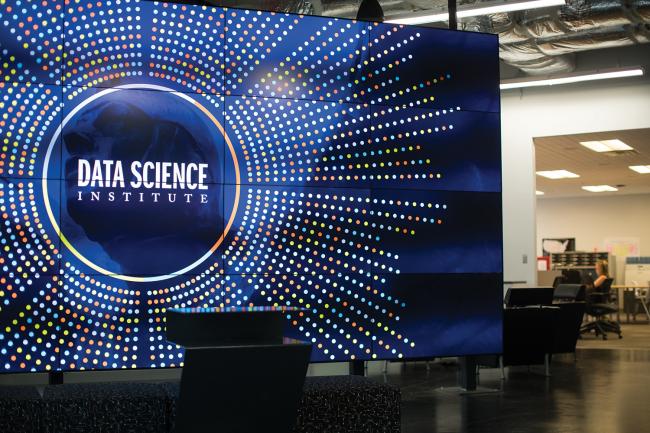Don Brown
Don Brown has been on the UVA faculty since 1985. In 2013 he became the founding director of the Data Science Institute and was instrumental in its creation. He currently serves as senior associate dean for research and Quantitative Foundation Distinguished Professor in Data Science.

Don Brown wasn’t sold the first time he spoke to Rick Horwitz about a big data initiative.
“I think I was nice to him,” he said. “But I was skeptical that this was going to lead to anything because I had watched UVA, multiple times, attempt various research initiatives, which had not gone well.”
When he met with Horwitz, Brown was certainly speaking with significant institutional knowledge. A West Point graduate and U.S. Army officer, Brown arrived at the University in 1985 after receiving his Ph.D. from the University of Michigan. In 1996, he became chair of the Department of Systems Engineering, a position he would hold for 12 years.
Early in his tenure at UVA, he was part of a team that received a substantial grant from the U.S. Department of Defense, which would be used to form the Institute for Parallel Computation, a collaboration with colleagues in the Department of Computer Science.
“You could call that sort of an early stab at some of these questions of data science and big data,” Brown said.
Despite his misgivings, Brown continued to meet with Horwitz.
“The thing about Rick,” he said, “was that he gave me a good story about why he thought the timing was right for big data.”
Soon, Brown was on board and their meetings continued, with a core group of around 10 faculty members from different schools across the University discussing what a big data initiative at UVA might look like.
Rick Horwitz and company would also enlist another important ally in John Simon, who took over as the University’s provost in September 2011. Momentum was building.
To gauge interest and bring together people with experience working with big data, plans were made to convene a summit focused on the concept that was developing.
The first Big Data Summit, a seminal event for data science at UVA, was held on May 9, 2012. The half-day gathering featured short presentations followed by panel discussions around the following themes: data producers; infrastructure issues and challenges; analytics and algorithms; and needs, opportunities, challenges, and next steps.
The overarching theme, though, was a clarion call to attendees to think creatively and without a preconceived notion of where this idea was headed: “Data, data everywhere without a plan in sight.”
By any measure, the summit was a success.
“It was just absolutely amazing,” said Horwitz. “It was beyond our expectations.”
“We were totally surprised,” said Don Brown of the interest and attendance, saying that they initially expected 60 to 80 faculty participants, not the 170 who attended from 32 departments.
“Far more than I anticipated,” Teresa Sullivan said.
The enthusiasm coming out of the first Big Data Summit, however, was marred, at least temporarily, by the forced resignation of Sullivan in June.
“It was devastating,” said Horwitz. After widespread protests, though, Sullivan was reinstated, and data science had its champion back in the president’s office.
In May 2013, a second Big Data Summit was held, with opening remarks from Brown, Sullivan, and Horwitz. The topics for this gathering showed the vast potential of data science to touch on a diverse range of disciplines and policies. Sessions focused on humanities, social sciences, and the arts; physical sciences and engineering; and biosciences and medicine.
There was no denying by the summer of 2013 that the time for big data at UVA had arrived; the next step was turning this vision into something concrete.
Sullivan asked Horwitz to present and promote the emerging concept around data science and a UVA institute at an early August retreat of UVA’s Board of Visitors. Their response was overwhelmingly positive, and they encouraged the group to move forward quickly with their plans.
At the same time that UVA leaders were organizing summits and making the case for an institute, alumni such as Jaffray Woodriff were independently advocating for the University to lead in data science.
In 2012, a few moments occurred in quick succession as efforts at UVA to push big data to the forefront were ongoing.
A much larger, national spotlight began to shine on the issue. First, major national media outlets would take notice, including an in-depth look by The New York Times, which christened the era “The Age of Big Data.”
Then, the Obama administration put the weight of the White House behind the issue, unveiling the “Big Data Research and Development Initiative” in March 2012.
“In the same way that past Federal investments in information-technology R&D led to dramatic advances in supercomputing and the creation of the Internet, the initiative we are launching today promises to transform our ability to use Big Data for scientific discovery, environmental and biomedical research, education, and national security,” said John Holden, director of the White House Office of Science and Technology Policy, in a statement announcing the effort.
While these events helped galvanize outside interest, Sullivan notes that efforts at the University were well underway.
“We’ve been thinking along these lines already, so I don’t think we reacted particularly to the outside interest,” she said. “We had our own internal dynamic underway already.”
In fact, there were two internal dynamics. While Rick Horwitz and his group were developing their ideas, Sullivan was proceeding on a parallel path.
After arriving at UVA, she was invited to join the Business-Higher Education Forum, a group that convenes senior high education officials and CEOs to discuss trends. Not long after joining, she participated in a session on data science. She recalls CEOs describing how, increasingly, job candidates did not have the skills that were required, adding that they thought they would soon need to outsource positions due a lack of needed talent in the U.S. — a potentially “alarming” development, Sullivan recalled.
Around the same time, she met with Robert Groves, director of the U.S. Census Bureau, who told her that it was critically important that college graduates not just be data literate but also be able to work with very large datasets.
Sullivan would soon meet and begin talking with Horwitz: “We were both on the same track — we just didn’t know it,” Sullivan said.
Horwitz, Don Brown, and their colleagues no longer needed to worry about finding a champion in the president’s office for data science. “I was actually prepared to sell them,” Sullivan said.
Teresa Sullivan organized a dinner with potential donors, including Jaffray Woodriff, who asked Rick Horwitz about the plans to establish a Data Science Institute at UVA. Woodriff liked what he heard about the institute but had one concern: Who would run it?
“I’m worried that they’re going to put someone in charge who is really academically focused who doesn’t also have applied success in data science,” Woodriff said. In fact, he had someone in mind: Don Brown.
Woodriff had only met Brown briefly at a conference 12 years earlier but was immediately impressed and viewed him as possessing both the academic credentials and real-world experience — Brown had owned a successful data science consulting firm in addition to his role as a UVA faculty member — to make the institute a success.
As Woodriff sat at dinner, both excited about the prospect of his dream of a data science institute becoming a reality and concerned about who would be at the helm, he was finally informed that Brown, his ideal candidate, would be in charge.
“I think I stood up and punched the air with my fist in celebration that it was going to be exactly the person I thought was best,” Woodriff recalled years later, a moment Sullivan vividly remembered as well.
“Don was exactly the kind of person he had seen as the leader for this effort,” she said.
Woodriff would ultimately donate $10 million to support the institute — a gift that would prove to be just the beginning of his support of data science at UVA.
“With his first gift, it became legitimate,” Horwitz said of the impact of Woodriff’s donation. “We had money to start doing things.”
Other external supporters would also emerge. Brown recalls that another UVA alum, Scott Stephenson of Verisk Analytics, wrote to the School of Engineering promoting the idea of a program centered around big data and industry. While the Engineering School did not act on it, Brown caught wind of the letter and did follow up.
"I said, 'Scott, we want to do what you're talking about,'" Brown said. "It was like the melding of minds, we came together," Brown said. Stephenson would provide substantial support over the years and would go on to chair the advisory board for the School of Data Science.
The Data Science Institute was ready to begin its work.



